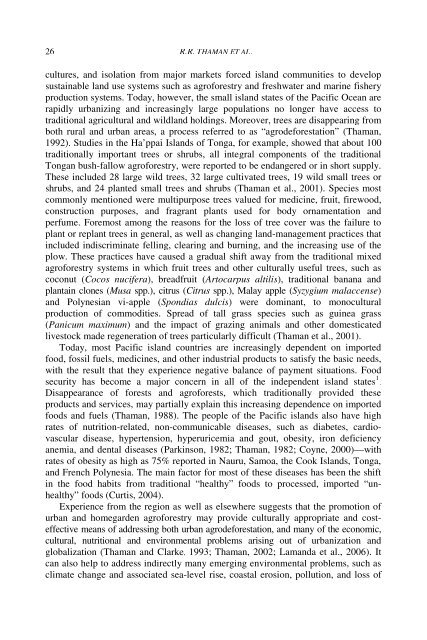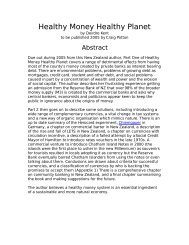Tropical Homegardens - library.uniteddiversity.coop
Tropical Homegardens - library.uniteddiversity.coop
Tropical Homegardens - library.uniteddiversity.coop
Create successful ePaper yourself
Turn your PDF publications into a flip-book with our unique Google optimized e-Paper software.
26 R.R. THAMAN T<br />
ET AL.<br />
cultures, and isolation from major markets forced island communities to develop<br />
sustainable land use systems such as agroforestry and freshwater and marine fishery<br />
production systems. Today, however, the small island states of the Pacific Ocean are<br />
rapidly urbanizing and increasingly large populations no longer have access to<br />
traditional agricultural and wildland holdings. Moreover, trees are disappearing from<br />
both rural and urban areas, a process referred to as “agrodeforestation” (Thaman,<br />
1992). Studies in the Ha’ppai Islands of Tonga, for example, showed that about 100<br />
traditionally important trees or shrubs, all integral components of the traditional<br />
Tongan bush-fallow agroforestry, were reported to be endangered or in short supply.<br />
These included 28 large wild trees, 32 large cultivated trees, 19 wild small trees or<br />
shrubs, and 24 planted small trees and shrubs (Thaman et al., 2001). Species most<br />
commonly mentioned were multipurpose trees valued for medicine, fruit, firewood,<br />
construction purposes, and fragrant plants used for body ornamentation and<br />
perfume. Foremost among the reasons for the loss of tree cover was the failure to<br />
plant or replant trees in general, as well as changing land-management practices that<br />
included indiscriminate felling, clearing and burning, and the increasing use of the<br />
plow. These practices have caused a gradual shift away from the traditional mixed<br />
agroforestry systems in which fruit trees and other culturally useful trees, such as<br />
coconut (Cocos nucifera), breadfruit (Artocarpus ( altilis),<br />
traditional banana and<br />
plantain clones (Musa spp.), citrus (Citruss spp.), Malay apple ( Syzygium malaccense)<br />
and Polynesian vi-apple (Spondias dulcis) were dominant, to monocultural<br />
production of commodities. Spread of tall grass species such as guinea grass<br />
(Panicum maximum) and the impact of grazing animals and other domesticated<br />
livestock made regeneration of trees particularly difficult (Thaman et al., 2001).<br />
Today, most Pacific island countries are increasingly dependent on imported<br />
food, fossil fuels, medicines, and other industrial products to satisfy the basic needs,<br />
with the result that they experience negative balance of payment situations. Food<br />
security has become a major concern in all of the independent island states 1 .<br />
Disappearance of forests and agroforests, which traditionally provided these<br />
products and services, may partially explain this increasing dependence on imported<br />
foods and fuels (Thaman, 1988). The people of the Pacific islands also have high<br />
rates of nutrition-related, non-communicable diseases, such as diabetes, cardiovascular<br />
disease, hypertension, hyperuricemia and gout, obesity, iron deficiency<br />
anemia, and dental diseases (Parkinson, 1982; Thaman, 1982; Coyne, 2000)—with<br />
rates of obesity as high as 75% reported in Nauru, Samoa, the Cook Islands, Tonga,<br />
and French Polynesia. The main factor for most of these diseases has been the shift<br />
in the food habits from traditional “healthy” foods to processed, imported “unhealthy”<br />
foods (Curtis, 2004).<br />
Experience from the region as well as elsewhere suggests that the promotion of<br />
urban and homegarden agroforestry may provide culturally appropriate and costeffective<br />
means of addressing both urban agrodeforestation, and many of the economic,<br />
cultural, nutritional and environmental problems arising out of urbanization and<br />
globalization (Thaman and Clarke, 1993; Thaman, 2002; Lamanda et al., 2006). It<br />
can also help to address indirectly many emerging environmental problems, such as<br />
climate change and associated sea-level rise, coastal erosion, pollution, and loss of














